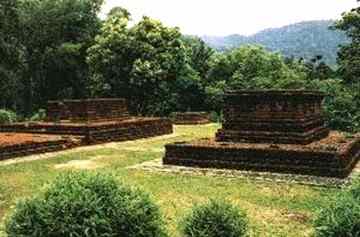The discovery of a 110AD monument in the Bujang Valley could have given archeological tourism a kickstart but sadly, it has not so far, writes SUBHADRA DEVAN.
 THEY came, they built, they exported. All in Sungai Batu, part of the archaeological expanse we call Lembah Bujang (Bujang Valley) in Kedah, way back in 110AD.
THEY came, they built, they exported. All in Sungai Batu, part of the archaeological expanse we call Lembah Bujang (Bujang Valley) in Kedah, way back in 110AD.
Given the easy accessibility to the sites, Bujang Valley is a good start for our country's archaeological tourism. However, it seems to need a kickstart as it is today underrated -- even among the local populace.
Historical records state that the Bujang Valley civilisation existed long before neighbouring empires such as Majapahit (1200 AD) and Sri Vijaya (700 AD).
However, the Sungai Batu find has made it the oldest man-made structure to be recorded in Southeast Asia. It is not clear still if it was for a religious purpose and the people who were there dealt with iron, smelting and export, which was unusual.
The Sungai Batu historical area, of which there are 97 identified sites, was unearthed by Universiti Sains Malaysia Penang's Centre for Global Archaeological Research (CGAR) team only last year.
The startling discoveries unearthed from 10 of the 97 sites include jetty remains, iron smelting sites, and a clay brick monument boasting a round base with a square top with what could have been a pole in the centre.
The CGAR team revealed its findings at a conference, co-organised by the National Heritage Department, in June in Kuala Lumpur.
"Since then", says CGAR director Associate Professor Mokhtar Saidin, "four more new sites have been unearthed. The area already excavated covers less than a square kilometre."
New estimates now show that the Bujang Valley settlement covers 1,000sq km, mostly around Gunung Jerai, formerly called Kedah Peak, and not 400sq km as previously believed.
The Sungai Batu sites are not tucked away deep in the jungle, unlike scenes in films like Lara Croft -- Tomb Raider. It sits smack on both sides of a highway from Sungai Petani, nestled in an oil palm plantation. You just stop the car, get out, and look.
While CGAR has a guard stationed at the main site which hosts the round base-square-top monument, tourist buses and drive-throughs are welcomed.
The team has stated that the finds, which included seven furnaces used for smelting of iron, reveal an iron industry flourished in Sungai Batu, almost 2,000 years ago.
Mokhtar says that the four new sites excavated compound the earlier iron industry findings. "It was an intensive industry."
Among the four new finds was another jetty excavated at the other end of the Sungai Batu river, which says Mokhtar, shows that "both sides of the old Sungai Batu river was used during that period".
To him, the findings still do not reveal who these ancient people were, only that they were "well versed in iron technology".
Undeniably, Sungai Batu and the greater Bujang Valley offer a taste of our archaeological history.
National Heritage commissioner Prof Emeritus Datuk Siti Zuraina Abdul Majid has said it would take two generations before all or even most of Bujang Valley is excavated. "What we've done is just 10 per cent of the work."
Earlier archeological artifacts found at Lembah Bujang are now housed at the Bujang Valley Archaeological Museum in Merbok, which is a turn off the road leading to the new site.
The earliest finds started being unearthed in 1845, in and around Sungai Muda, Sungai Merbok and Sungai Bujang.
The museum, which opened in 1980, offers a trail of archeological history starting with relics like a statue of Lord Ganesha and a bronze image of Lord Vishnu, to stone tablets of Pallavi script to Lord Buddha, and Islam.
Outside the air-conditioned museum house is a complex of temples, which were found at the Merbok estuary, at the foothills of Gunung Jerai.
Critics have often wondered why these temples had been moved from the original sites at all.
The museum sees busloads of foreign tourists, especially during the summer holidays in the West. What they will see in the complex grounds are just half-built temples as their wooden roofings have rotted and withered over the past 1,000 years.
On the summit of a small hill behind the museum stands Candi Bukit Batu Pahat, said to have been built in the 7th Century AD.
What is lacking for a visitor is an imaginative replica of what any one of these temples -- or candi from "Chandika", the name of Lord Siva's wife -- looked like in its heyday.
Sadly, even the signboards explaining these remnant structures are also completely faded, an example perhaps of a lackadaisical attitude to what could be a money-spinner as in Angkor Wat and Borobodur.
Author: Subhadra Devan | Source: New Straits Times [September 19, 2010]